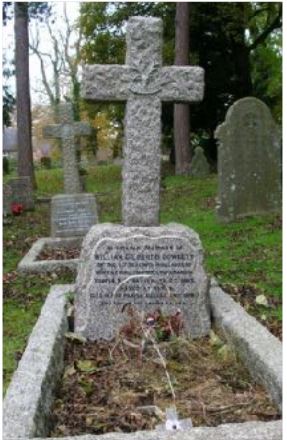6th Battalion, Seaforth Highlanders

William Gilbert Bailey Dowsett, known as Gilbert, was born at Hallyburton, Coupar Angus, Forfar, Scotland on 2 September 1889, the third child of Charles and Frances Lucy Pelling Gilbert (née Bailey). His siblings were Charles William (1875-1952), Roland Bailey (1881-1978) and Lucy Gladys Bailey (1891-1840).
In 1891, he was living with his parents at 24 Elvaston Mews, Kensington, London, and his father’s occupation was a coachman. In 1901 Gilbert was living at the family home, 39 Lithos Road, Hampstead, London, and his father was a cab proprietor.
By 1911, William, a single man, was living at the family home in Lithos Road which was now a lodging house run by his widowed father, and sister Lucy. His occupation was a cabinet maker’s salesman and he joined up for military service from the home address.
William married Margaret Hill at Islington, London in the spring of 1914, before leaving for France in the Great War.
William enlisted on 15 September 1914 to serve with the 6th Battalion, Seaforth Highlanders, a Territorial Force (TF) unit and records show that his regimental number, 2129, was replaced by 265647, when TF unit service numbers were changed to six figure digits in 1917. His next of kin was given as Charles Dowsett, and it was noted he was 6 feet in height and his previous trade occupation was an architect.
He served at home from 15 September 1914 to 30 April 1915, in the Expeditionary Force from 1 May to 28 November 1915, and again at home from 29 November 1915 to 10 March 1917, and was purportedly gassed at Ypres.
His medical record reflects he was admitted to Willencourt Hospital, 33 miles from Arras, France (11 to 12 November 1915), then to General Hospital, Rouen, Normandy, France on 15 November, before being transferred to England on 29 November 1915 to be admitted to the Racecourse Hospital, Cheltenham (30 November 1915 to 12 July 1917). The Racecourse was one of eight Voluntary Aid Detachment (VAD) Hospitals in Cheltenham during the Great War. A report from the Racecourse Hospital on 2 July 1917 referred to him as Lance Corporal, and that his disability (tuberculosis of the larynx and lungs) originated in the middle of October 1915 at Thiepval, France ‘after violent shelling aroused chalk (missiles?). He then spent four months in Downs Sanatorium before going to Fitzroy Square Mount Vernon Hospital, Hampstead, London, close to the family home, in November 1917.
William died at Elkstone on 28 August 1918, aged 28 years, and was buried on the north side of Elkstone Churchyard on 1 September. The position of the plot would indicate that he was a stranger to the parish, and it is not known how he came to be living in the village. Furthermore, it is a mystery that the Commonwealth War Graves Commission refers to him as being the son of Tom Dowsett, Sydney, Australia.
Other than the memorial at Elkstone, there appears to be no further commemoration for William Dowsett.
Researched by Baden Russell October 2010
(In compiling this article thanks are due to Sylvie Pierce, patron of Elkstone Church.)
